The Cosmic Creation contest challenge us to imagine the art of Mythology. For years, I've been intrigued by a book called the Popol Vuh, which in the Kʼicheʼ language of this Mesoamerican Mayan indigenous people. The Popol Vuh (or the Book of the Community/Counsel) contains the myths, legends, culture, and history of the K’iche’ people. The book is wrapped in layers of mystery because it was written around 1554-58 by members of the beleaguered Mayan nobility, whom after seeing the destruction of their codices at the hand of the freshly arrived conquistadors, decided to write for posterity one of the most astonishing books ever written. Thanks to their noble and rebellious efforts, the K'iche' authors were able to preserve the voices of these ancient Maya people (Christenson, 2007).
The Popol Vuh chronicled the stories of creation, the acts of Gods and sages, the origins of the K’iche’ people and the succession of kings throughout their history (Christenson, 2007). It was re-discovered by a Spanish priest called Francisco Ximénez. The books had been kept hidden by the K’iche’ elders and their contents committed to memory. The Maya had a long history of oral traditions by which they were able to store their knowledge, but they also had a comprehensive writing system. Over two hundred years after the Popol Vuh was written, Francisco Ximénez convinced the K’iche’ elders to let him see it, so he could make a copy of its contents (Christenson, 2007). The elders must've realized that making a copy of the book and disseminating its contents was probably a good idea to keep the memory of their people alive.
The original Popol Vuh written by the K'iche' aristocrats was based on ancient codices that the authors managed to save from the burning pyres of the Spanish clergy, whom believed the book contained “superstition and lies of the devil” that “might harm the Indians in matters concerning religion” (Christenson, 2007). The nobility in the 16th century had a few of those ancient codices written in hieroglyphics, and they decided to make copies in their K’iche’ language before these too were burned.
If the Precolumbian version of the Popol Vuh was like other ancient texts from the lowlands, it was painted on long strips of bark paper or deer skin which were given a thin coating of lime plaster to create a smooth writing surface, and then folded accordion style into a codex book.
(Christenson, 2007)
Neither the original codices or the First edition of the Popol Vuh have been seen in centuries. The only account we have is the copy made by Francisco Ximénez whose bravery and foresight allows us to hear those ancient voices. The fascinating thing about the original hieroglyphic system is that it had a phonetic (word sound) and logographic (graphical illustration of word or concept) component (Christenson, 2007). It was meant to be heard as well as seen like a set of moving images. Apparently, it was such an amazing written language that the Spanish missionary Bartolome de las Casas wrote that he was impressed upon seeing the “figures and characters by which they could signify everything they desired... these great books are of such astuteness and subtle technique that we could say our writing does not offer much of an advantage” (as quoted in Christenson, 2007)
For the Alien Art Hive Cosmic Creations art challenge, I decided to create some AI art based on the creation myths detailed in the Popol Vuh. The book begins with the creation of the world, which occurs in different stages. The description of these stages was gleaned from Christenson’s (2007) English translation of the Popol Vuh. I rely on this translation, along with Christenson's extensive commentary to create the art and draft the facts presented in this post.
For the prompt, I mainly used the same words and phrases that are used in the book, but I did take the liberty of rearranging some words and phrases to facilitate prompt engineering. Each part of the prompt was prefaced with the words “Myth of the Popol Vuh” and the word 'Maya' in some parts. The titles for each section are taken from Christenson’s (2007) translation as well. I provide the direct quotes from the ancient tome that seemed the most relevant, but keep in mind that the actual book is much more extensive and complex. I also picked and chose only elements of the quotes you're about to read. Then there's the whole complexity of "lost in translation", particularly when it comes to a written language that was meant to be both seen graphically and heard auditorily. Christenson provides a thorough account of this book from an anthropological, ethnographic, and linguistic perspective. So, it's worth a read.
Christenson, Allen J. 2007. Popol Vuh: The Sacred Book of the Maya. Oklahoma ed. Norman: University of Oklahoma Press. http://catdir.loc.gov/catdir/toc/ecip0620/2006028164.html.
The Primordial World
THIS IS THE ACCOUNT of when all is still silent and placid. All is silent and calm. Hushed and empty is the womb of the sky.
THESE, then, are the first words, the first speech. There is not yet one person, one animal, bird, fish, crab, tree, rock, hollow, canyon, meadow, or forest. All alone the sky exists. The face of the earth has not yet appeared. Alone lies the expanse of the sea, along with the womb of all the sky. There is not yet anything gathered together. All is at rest. Nothing stirs. All is languid, at rest in the sky. There is not yet anything standing erect. Only the expanse of the water, only the tranquil sea lies alone. There is not yet anything that might exist. All lies placid and silent in the darkness, in the night.
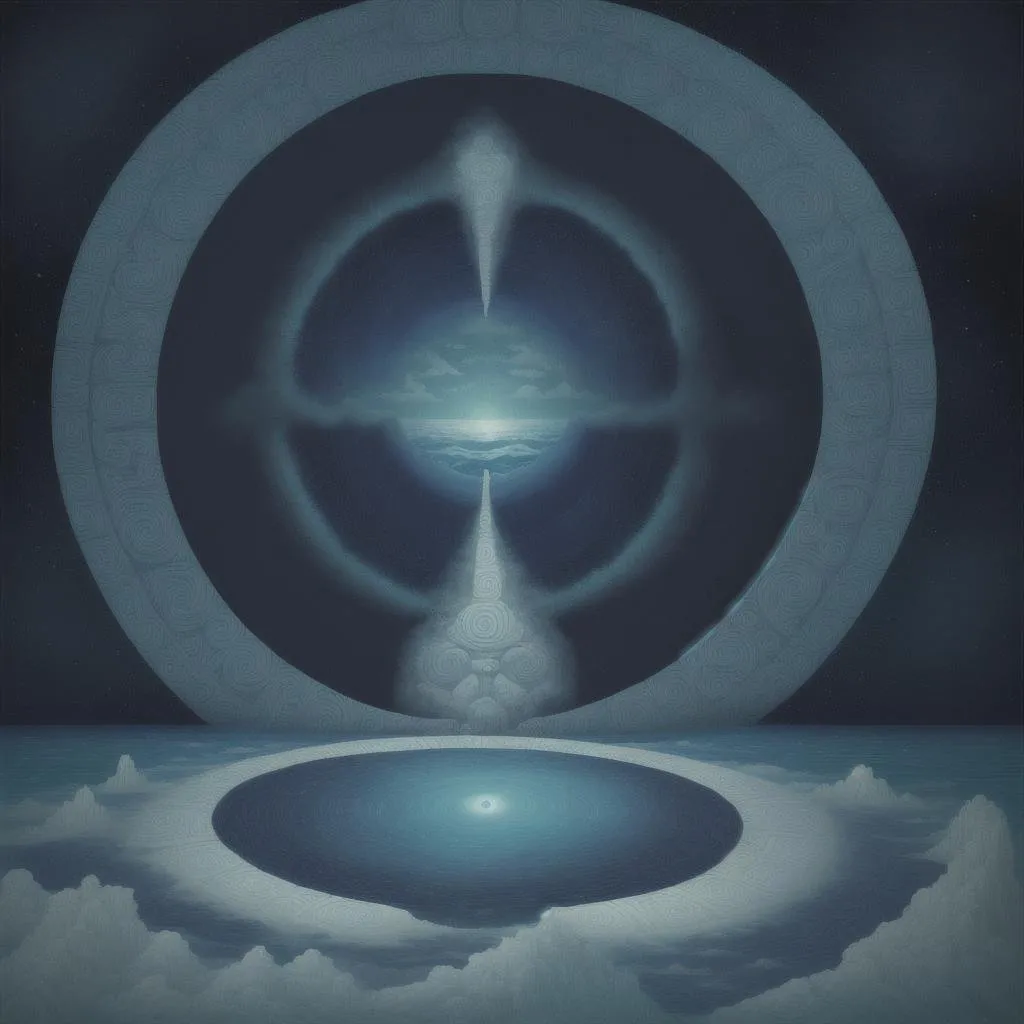

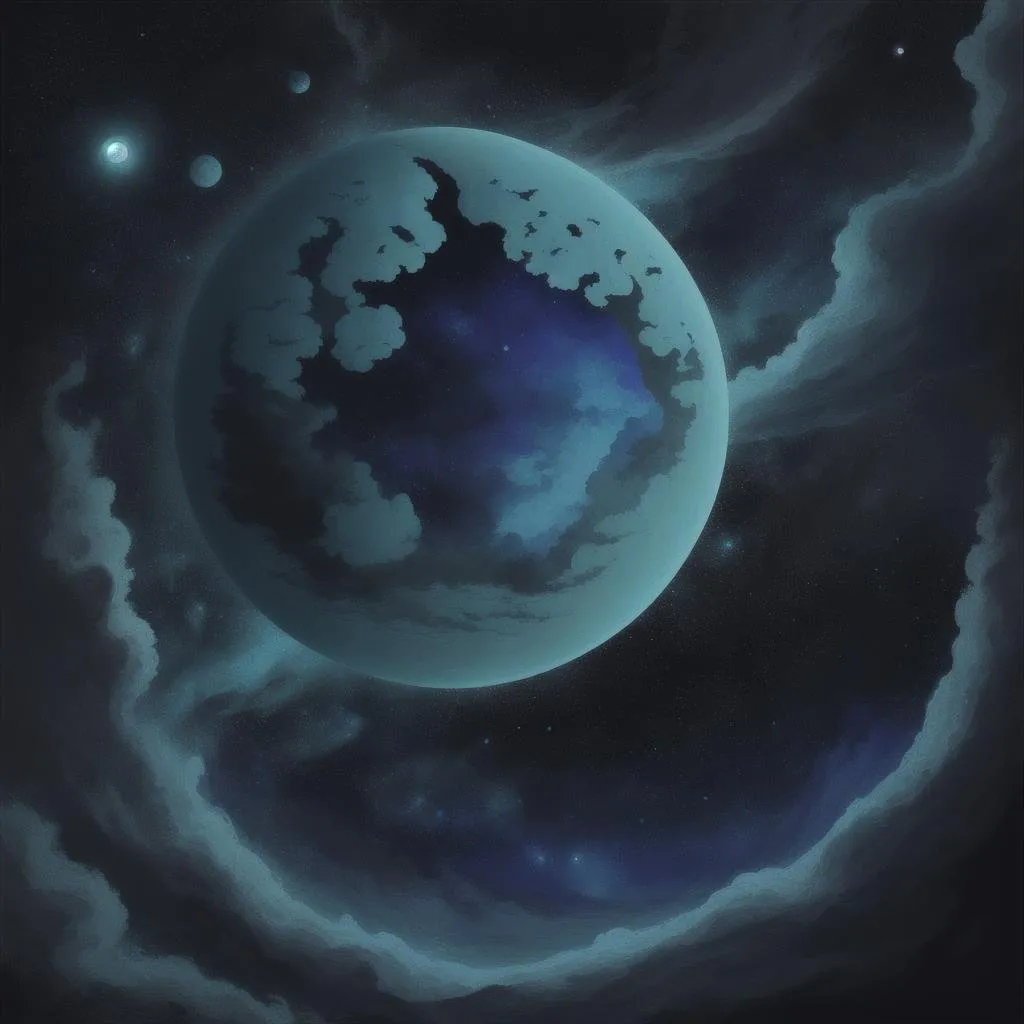
Note: It was difficult trying to get the software to generate images with no mountains, animals, moons, stars, and so on. So I used some words and phrases in the book as negative prompts. In the end, the software couldn't help itself and kept putting stars and other objects in the sky.
The Creation of the Earth
Then the earth was created by them. Merely their word brought about the creation of it. In order to create the earth, they said, “Earth,” and immediately it was created. Just like a cloud, like a mist, was the creation and formation of it...
Then they called forth the mountains from the water. Straightaway the great mountains came to be. It was merely their spirit essence, their miraculous power, that brought about the conception of the mountains and the valleys. Straightaway were created cypress groves and pine forests to cover the face of the earth...
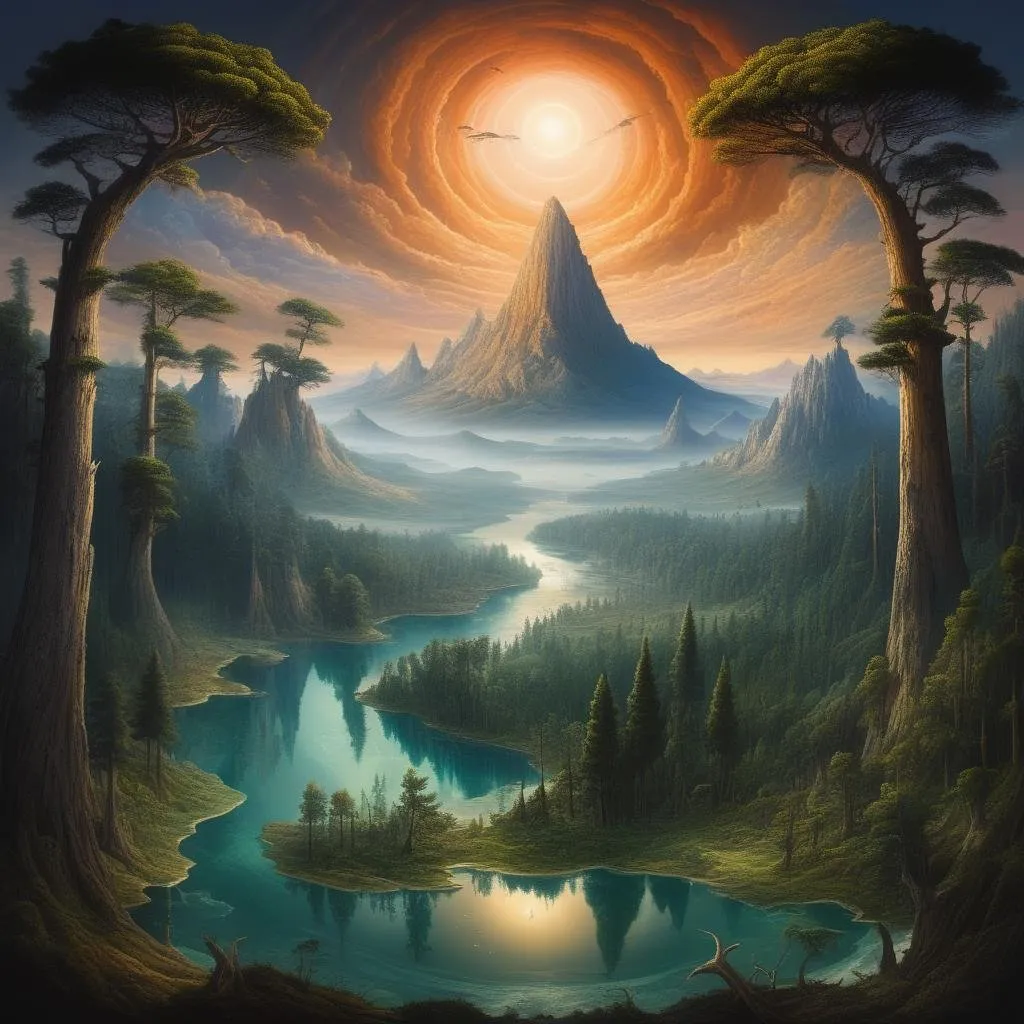
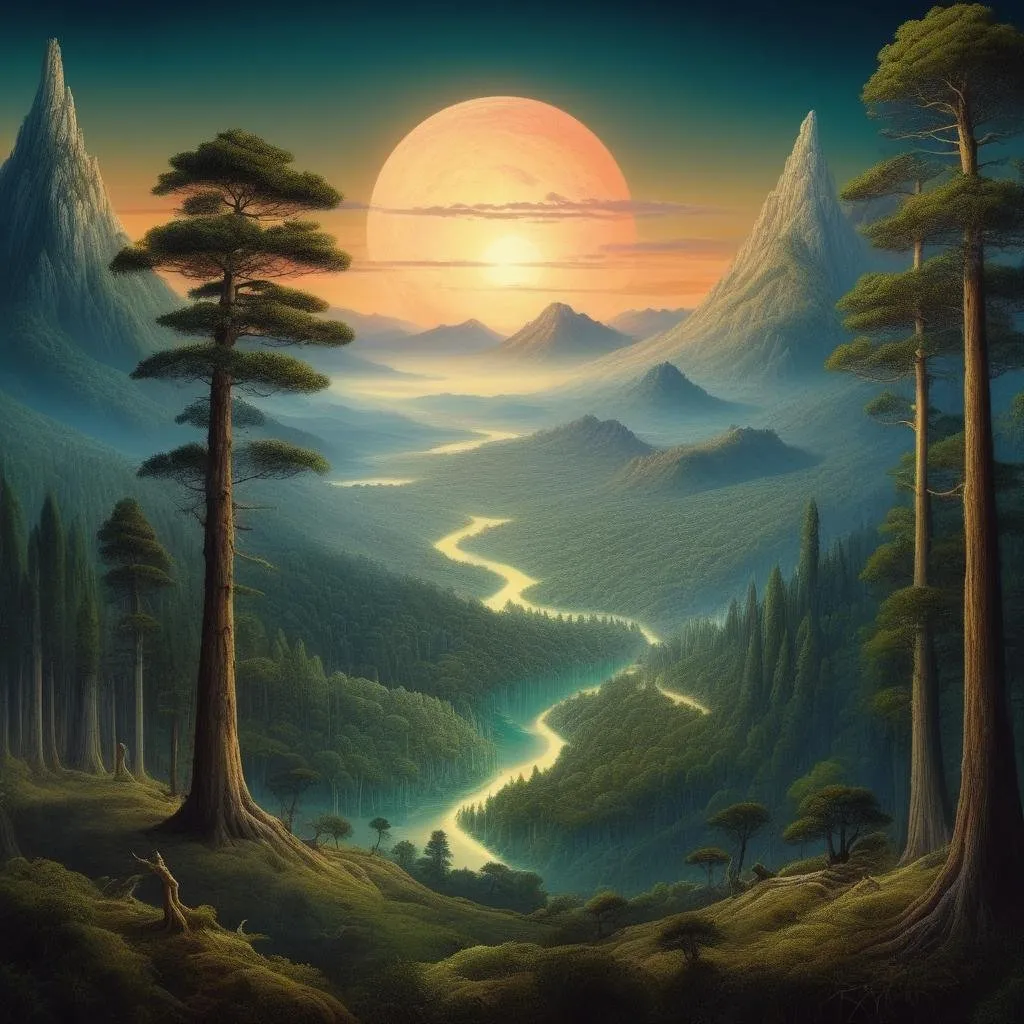
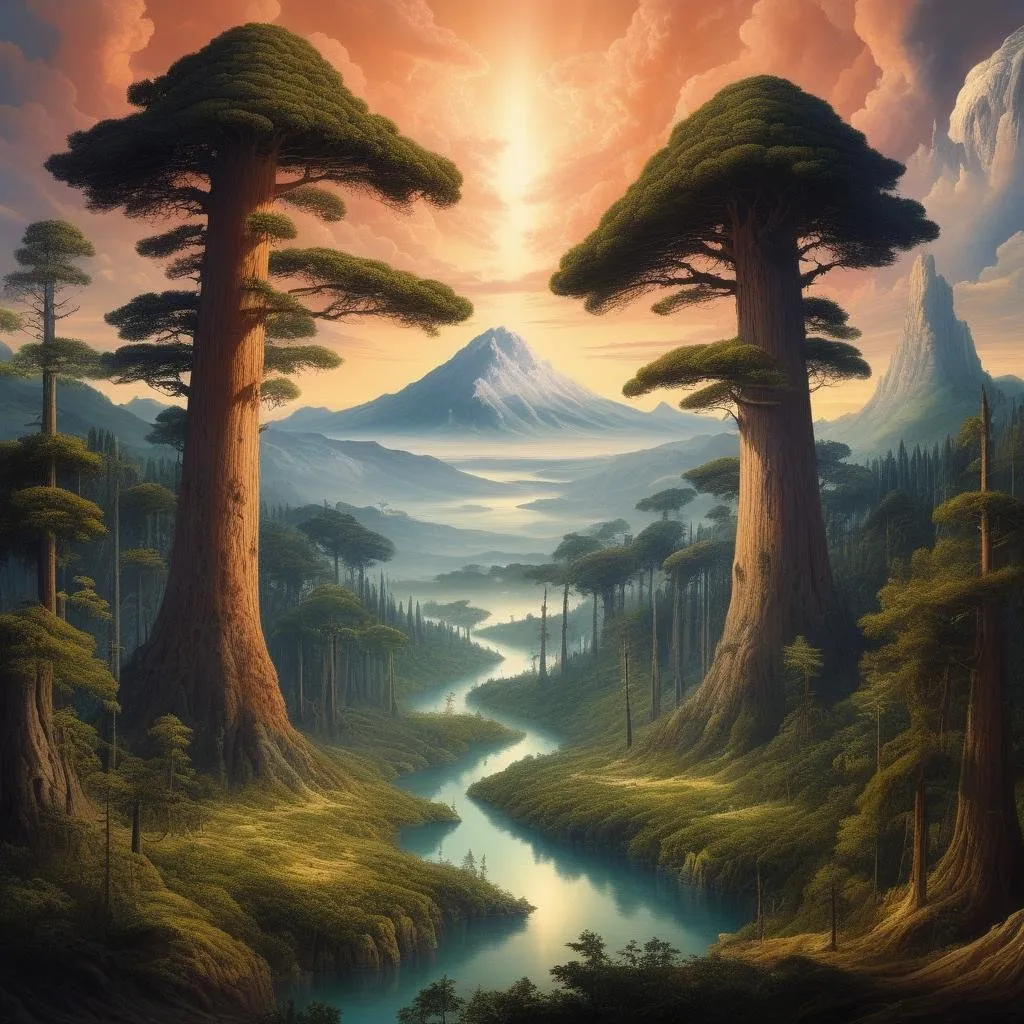
The Creation of Animals
Speak! Call! Don't moan or cry out. Speak to one another, each according to your kind, according to your group,” they were told—the deer, the birds, the pumas, the jaguars, and the serpents...
Speak therefore our names. Worship us, for we are your Mother and your Father…
But they did not succeed. They did not speak like people. They only squawked and chattered and roared. Their speech was unrecognizable, for each cried out in a different way...
You shall be replaced because you were not successful. You could not speak. We have therefore changed our word. Your food and your sustenance, your sleeping places and your places to rest, that which belonged to you, shall be in the canyons and the forests...
“Nevertheless, because you have not been able to worship us or call upon us, there will yet be someone else who may be a worshiper. We shall now make one who will give honor. Your calling will merely be to have your flesh eaten. Thus be it so. This must be your service,” they were told. Thus were commanded the animals, both small and great, that were upon the face of the earth...
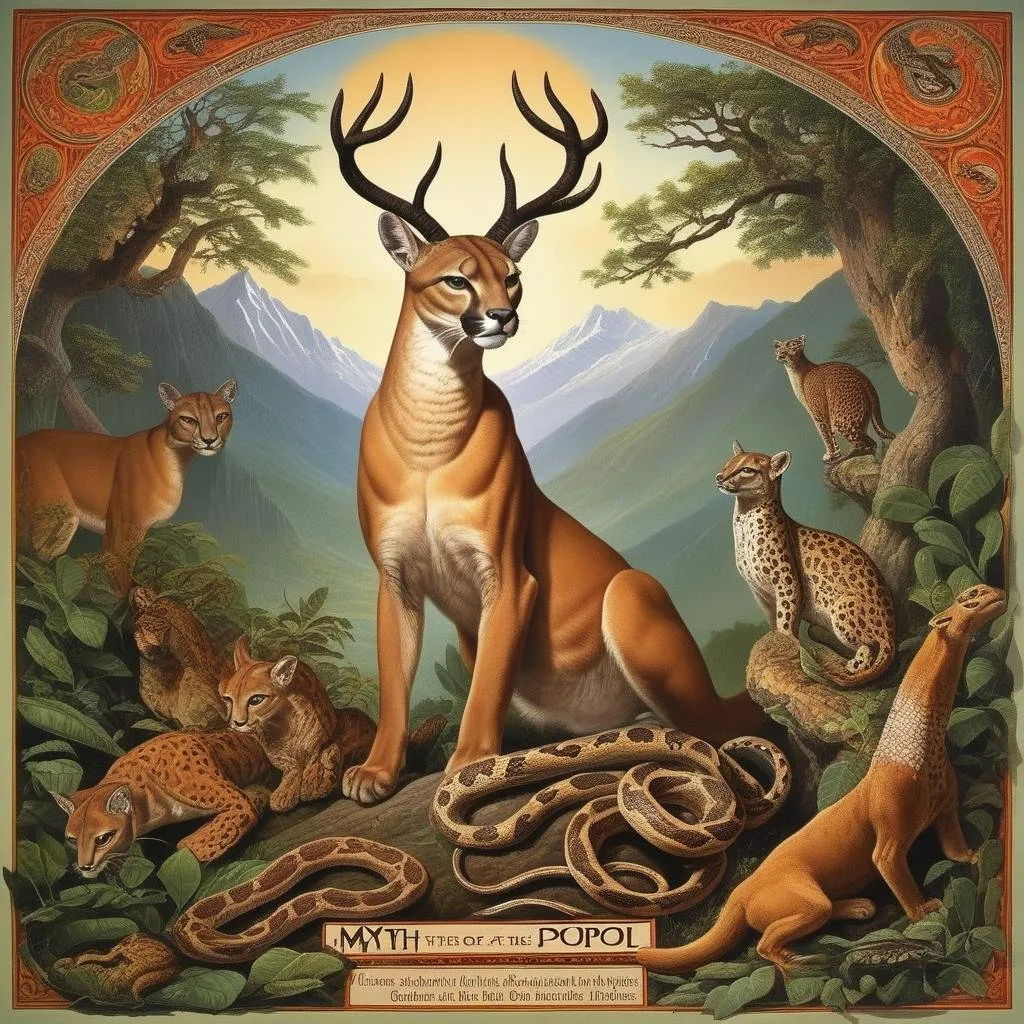
The Creation of the Mud Person
“Let us try again before the first sowing, before the dawn approaches. Let us make a provider, a sustainer for us. How shall we then be called upon so that we are remembered upon the face of the earth?...
“Of earth and mud was its flesh composed. But they saw that it was still not good. It merely came undone and crumbled. It merely became sodden and mushy. It merely fell apart and dissolved. Its head was not set apart properly. Its face could only look in one direction. Its face was hidden. Neither could it look about. At first it spoke, but without knowledge. Straightaway it would merely dissolve in water, for it was not strong...
“We have made a mistake; thus let this be merely a mistake. It cannot walk, neither can it multiply. Then let it be so. Let it be merely left behind as a thing of no importance,” they said...
“Therefore they undid it. They toppled what they had framed, what they had shaped.
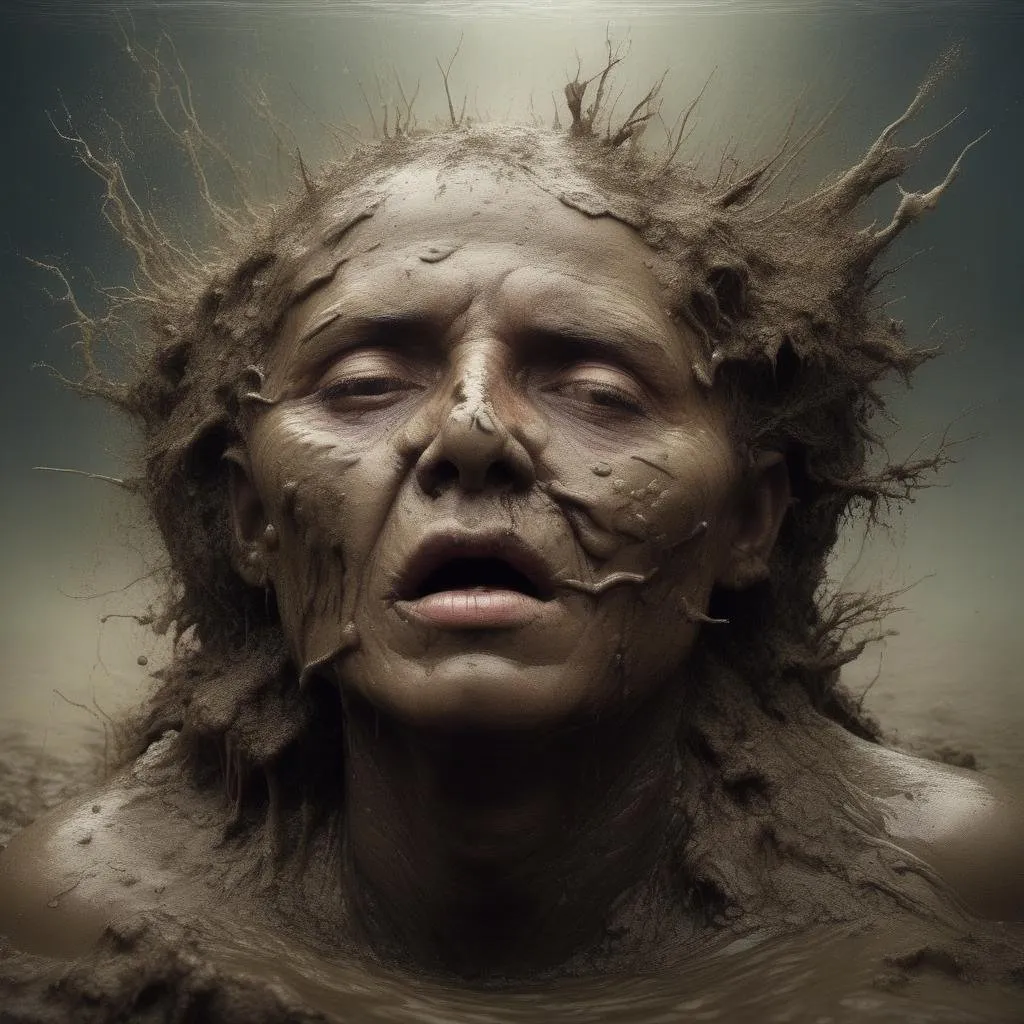
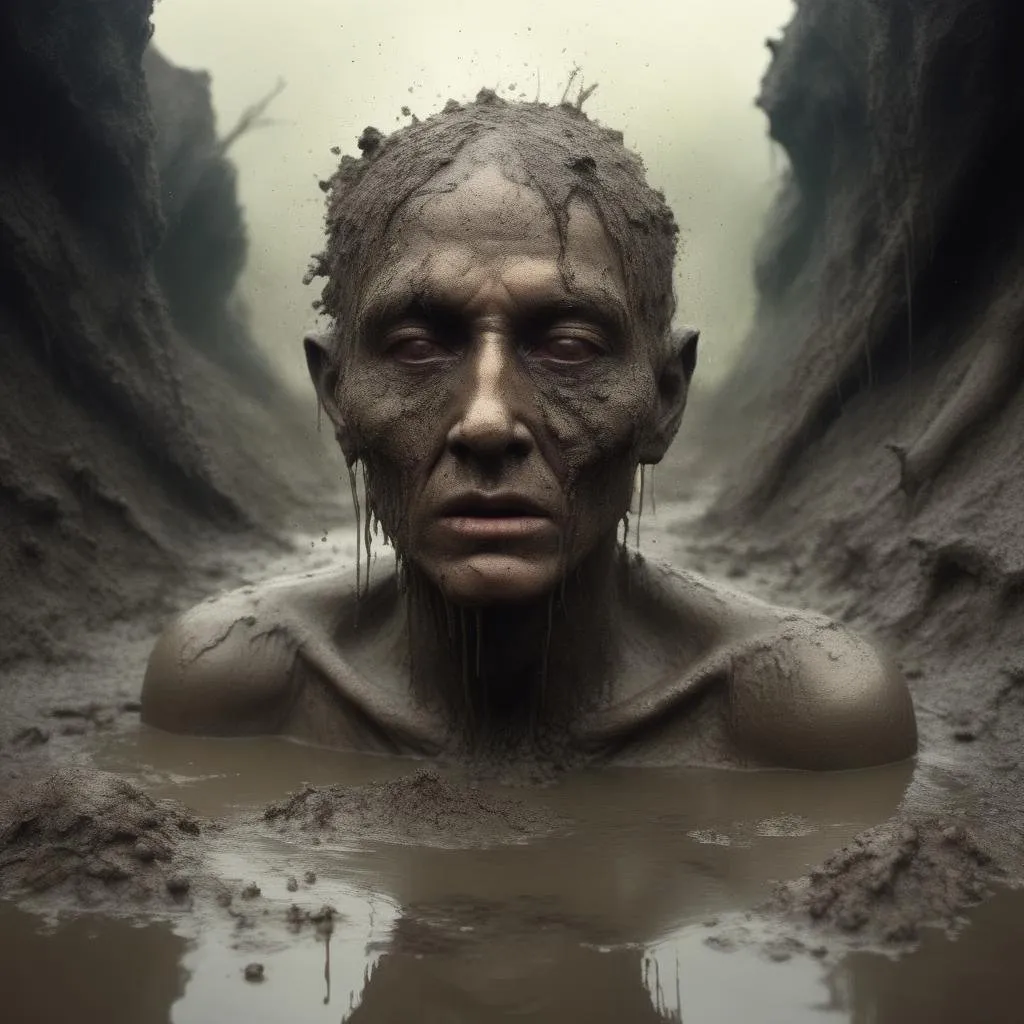
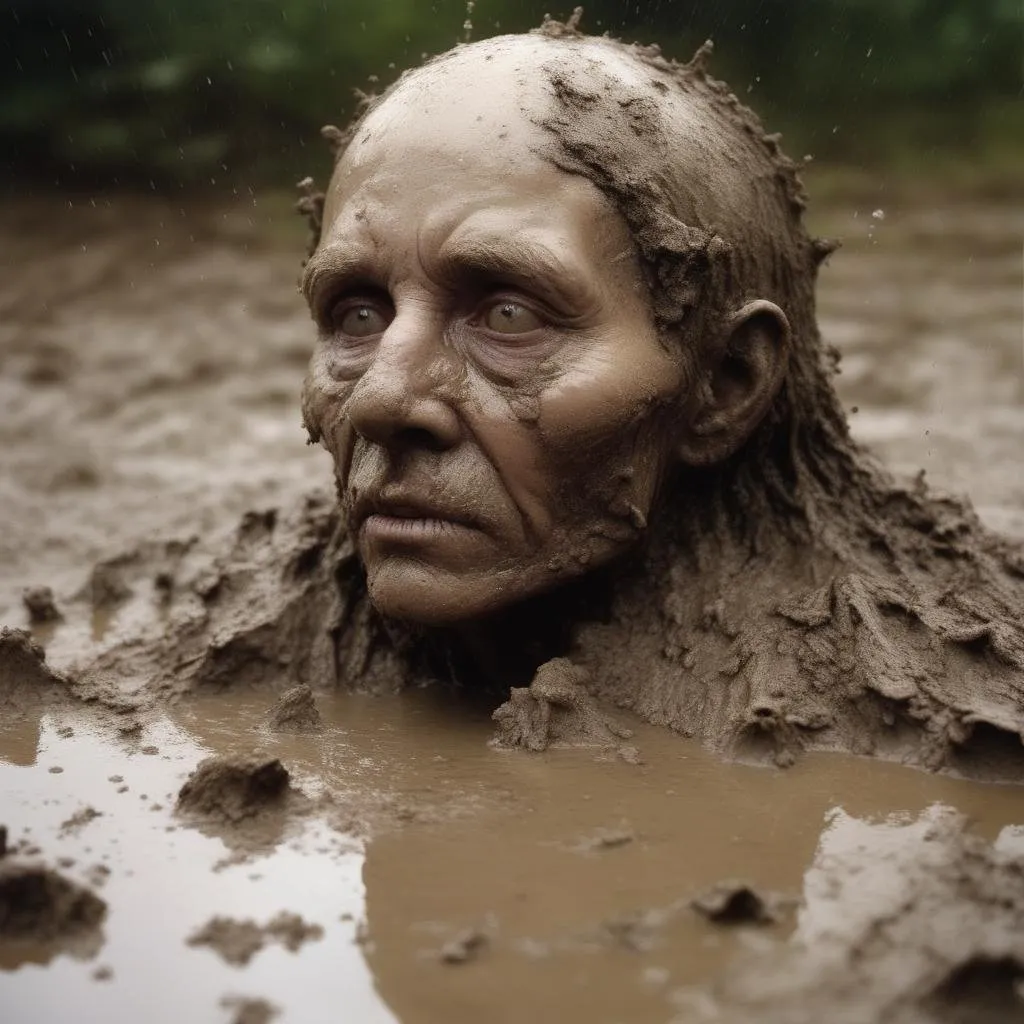
The Creation of the Effigies of Carved Wood
It shall be found; it shall be discovered how we are to create shaped and framed people who will be our providers and sustainers. May we be called upon, and may we be remembered. For it is with words that we are sustained, O Midwife and Patriarch, our Grandmother and our Grandfather, Xpiyacoc and Xmucane...
Cast grains of maize and tz'ite to divine how what we shall make will come out when we grind and chisel out its mouth and face in wood...
Thus they began to speak, to carry out their divination ceremony:
“May it be discovered. May it be found. Say it! Our ears hear you. Speak! Tell it! May the tree be found that is to be carved and chiseled out by the Framer and the Shaper...
If this is to be the provider and the sustainer, then may it now be sown that the dawn may come. You, grains of maize, and you, tz'ite; you, days, and you, the shaping—you are called, you are summoned.” Thus it was said to the grains of maize and the tz'ite, to the days and the shaping...
“May these effigies of wood come out well. May they speak. May they communicate there upon the face of the earth. May it be so,” they said.”
And when they had spoken, straightaway the effigies of carved wood were made. They had the appearance of people and spoke like people as well. They populated the whole face of the earth. The effigies of carved wood began to multiply, bearing daughters and sons...
Nevertheless, they still did not possess their hearts nor their minds. They did not remember their Framer or their Shaper. They walked without purpose. They crawled on their hands and knees and did not remember Heart of Sky. Thus they were weighed in the balance. They were merely an experiment, an attempt at people. At first they spoke, but their faces were all dried up. Their legs and arms were not filled out. They had no blood or blood flow within them. They had no sweat or oil. Their cheeks were dry, and their faces were masks. Their legs and arms were stiff. Their bodies were rigid. Thus they were not capable of understanding before their Framer and their Shaper, those who had given them birth and given them hearts. They were the first numerous people who have lived here upon the face of the earth.
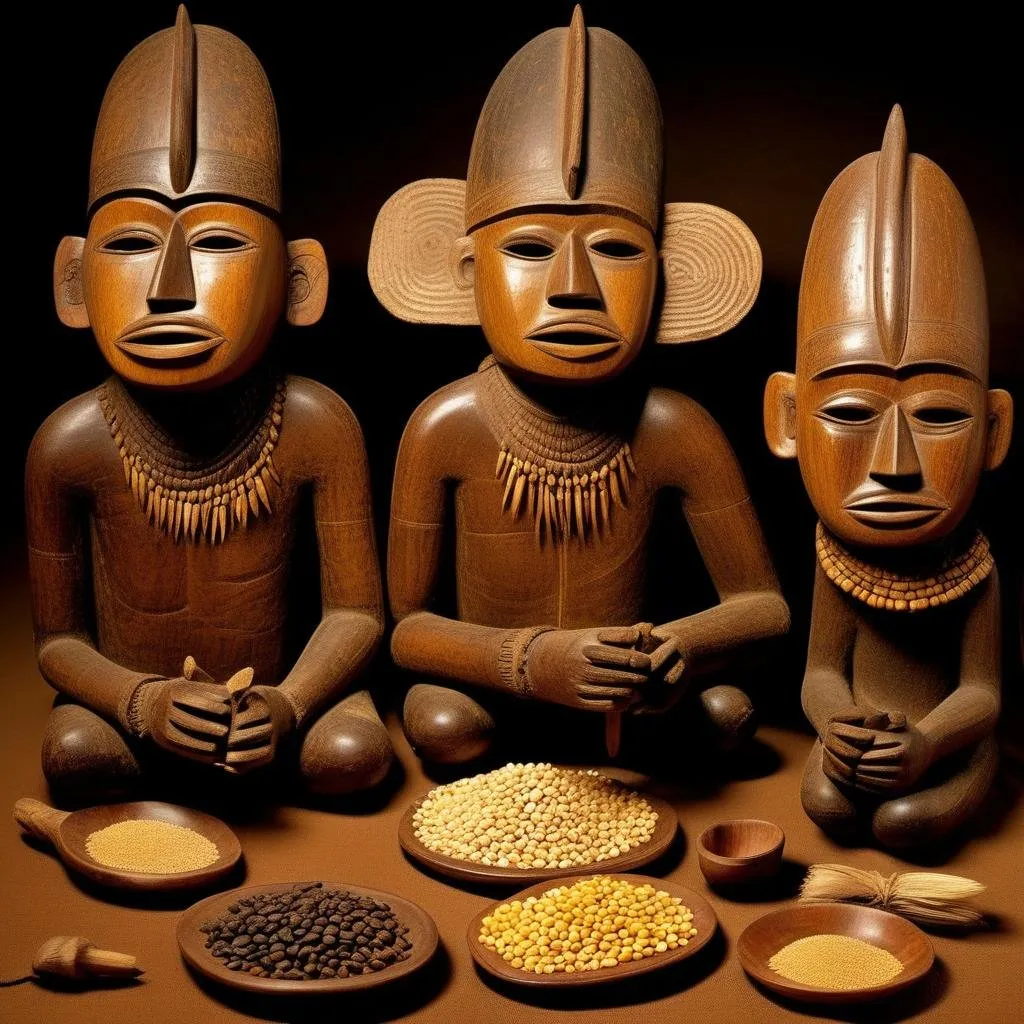
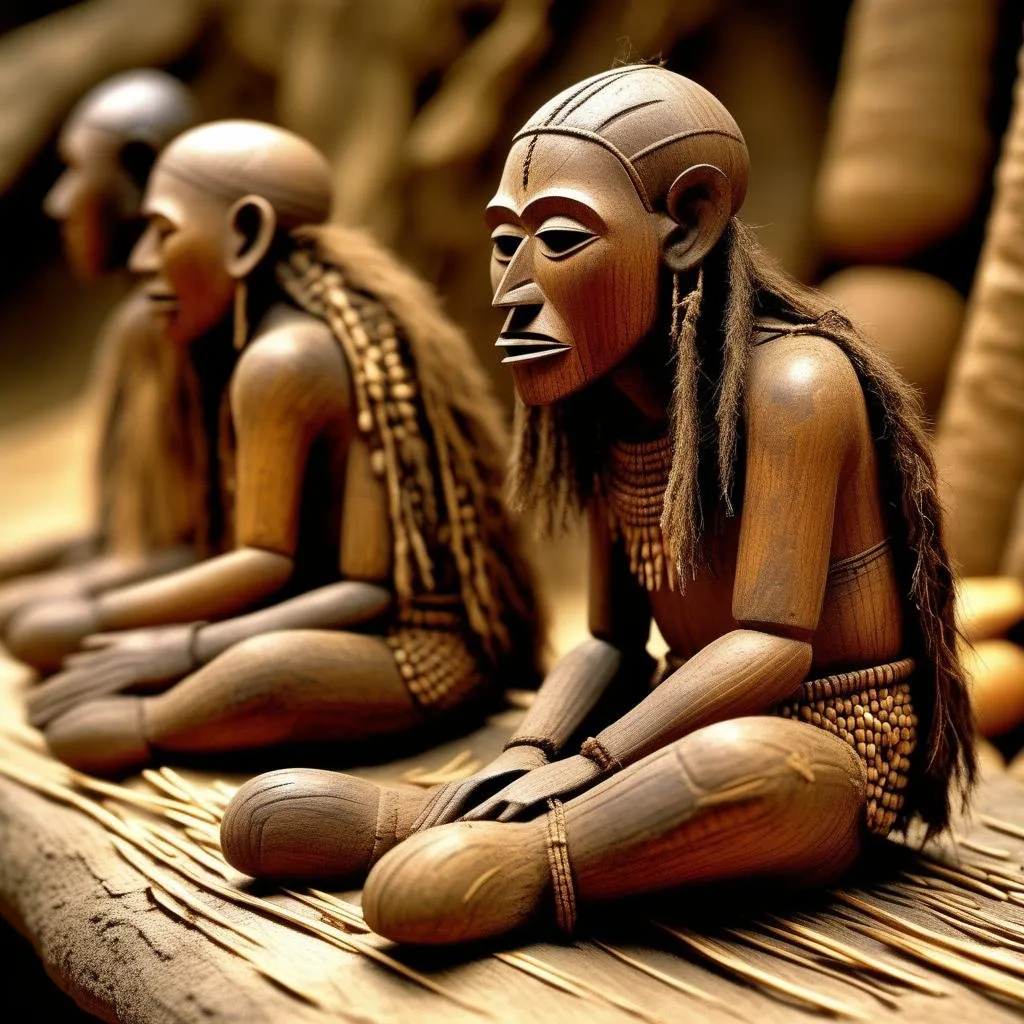
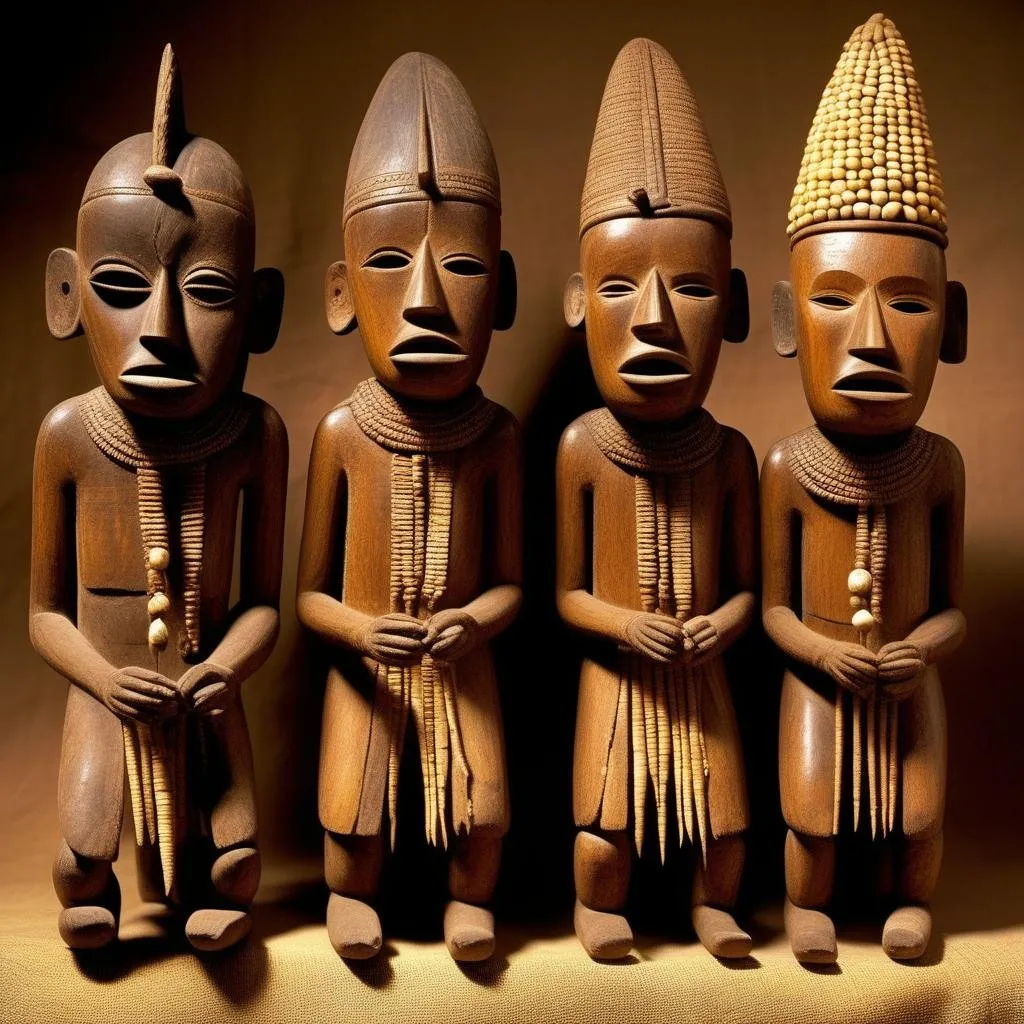
Note: At this point in the story, the effigies of wood meet a horrible end in a flood and gruesome attacks by animals, dishes, and tools. Then other myths and legends are told about the gods, heroes, sages, astute maidens, and other mythic personages before they get to the creation of humanity.
The Creation of Humanity
“The dawn approaches, and our work is not successfully completed. A provider and a sustainer have yet to appear—a child of light, a son of light. Humanity has yet to appear to populate the face of the earth,” they said...
Thus they gathered together and joined their thoughts in the darkness, in the night. They searched and they sifted. Here they thought and they pondered. Their thoughts came forth bright and clear. They discovered and established that which would become the flesh of humanity. This took place just a little before the appearance of the sun, moon, and stars above the heads of the Framer and the Shaper.
The Discovery of Maize
THESE were the names of the animals that obtained their food—fox and coyote, parakeet and raven. Four, then, were the animals that revealed to them the yellow ears of maize and the white ears of maize.

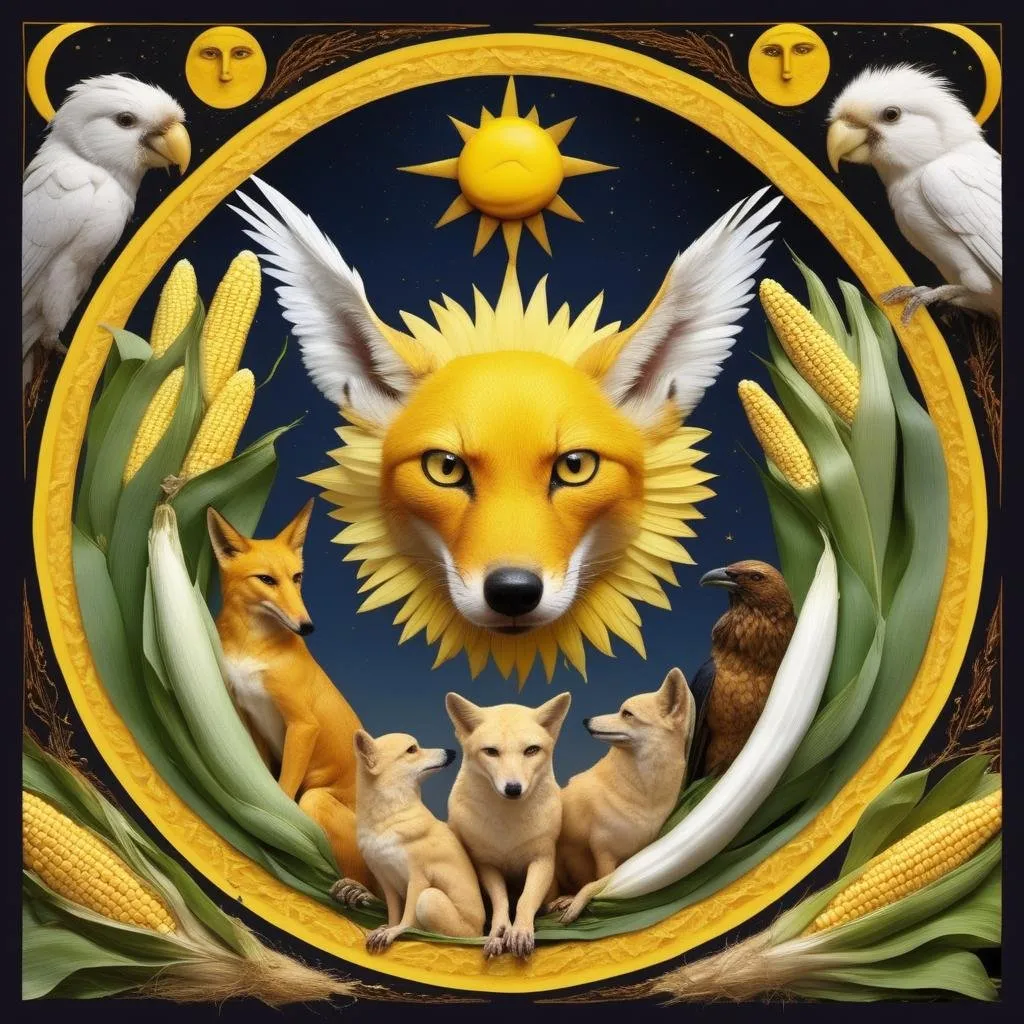
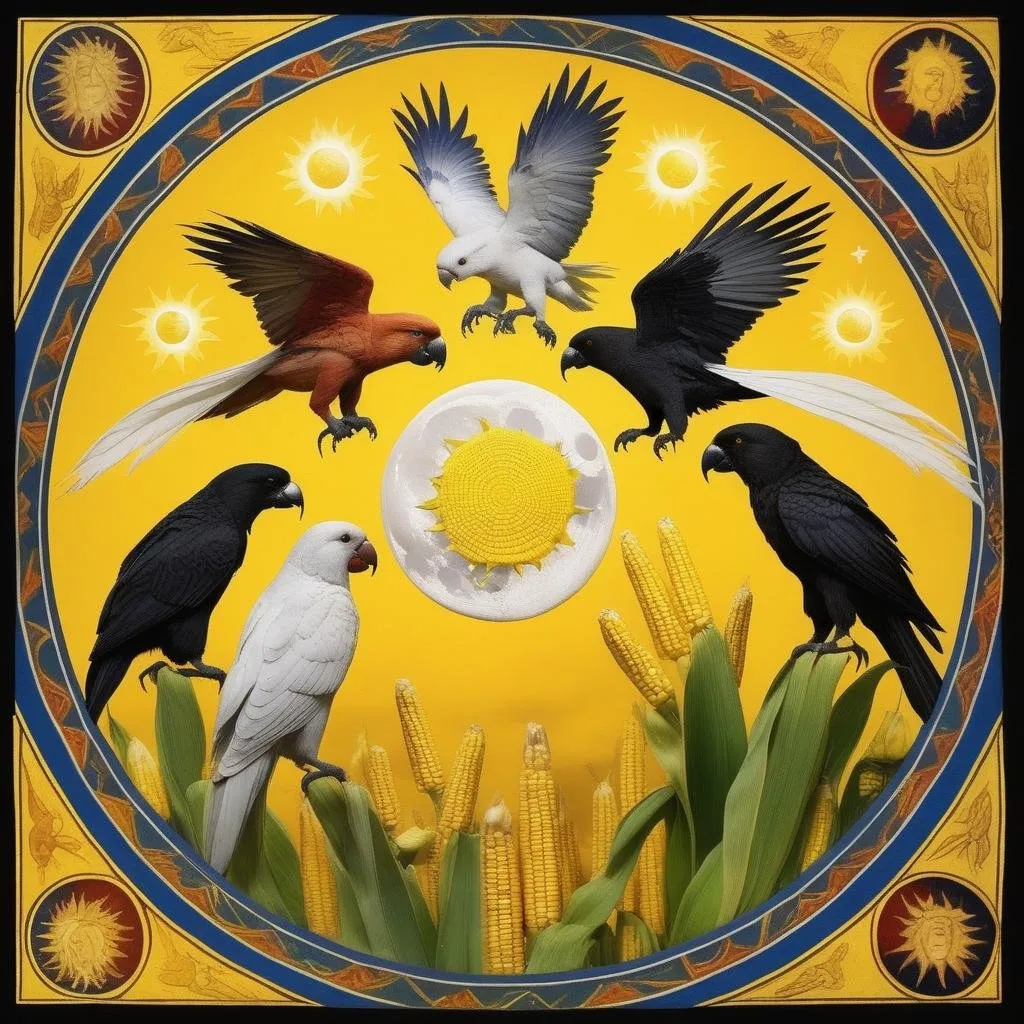
Thus was found the food that would become the flesh of the newly framed and shaped people. Water was their blood. It became the blood of humanity. The ears of maize entered into their flesh...
The yellow ears of maize and the white ears of maize were then ground fine with nine grindings by Xmucane. Food entered their flesh, along with water to give them strength. Thus was created the fatness of their arms. The yellowness of humanity came to be when they were made by they who are called She Who Has Borne Children and He Who Has Begotten Sons, by Sovereign and Quetzal Serpent...
Thus their frame and shape were given expression by our first Mother and our first Father. Their flesh was merely yellow ears of maize and white ears of maize. Mere food were the legs and arms of humanity, of our first fathers. And so there were four who were made, and mere food was their flesh...
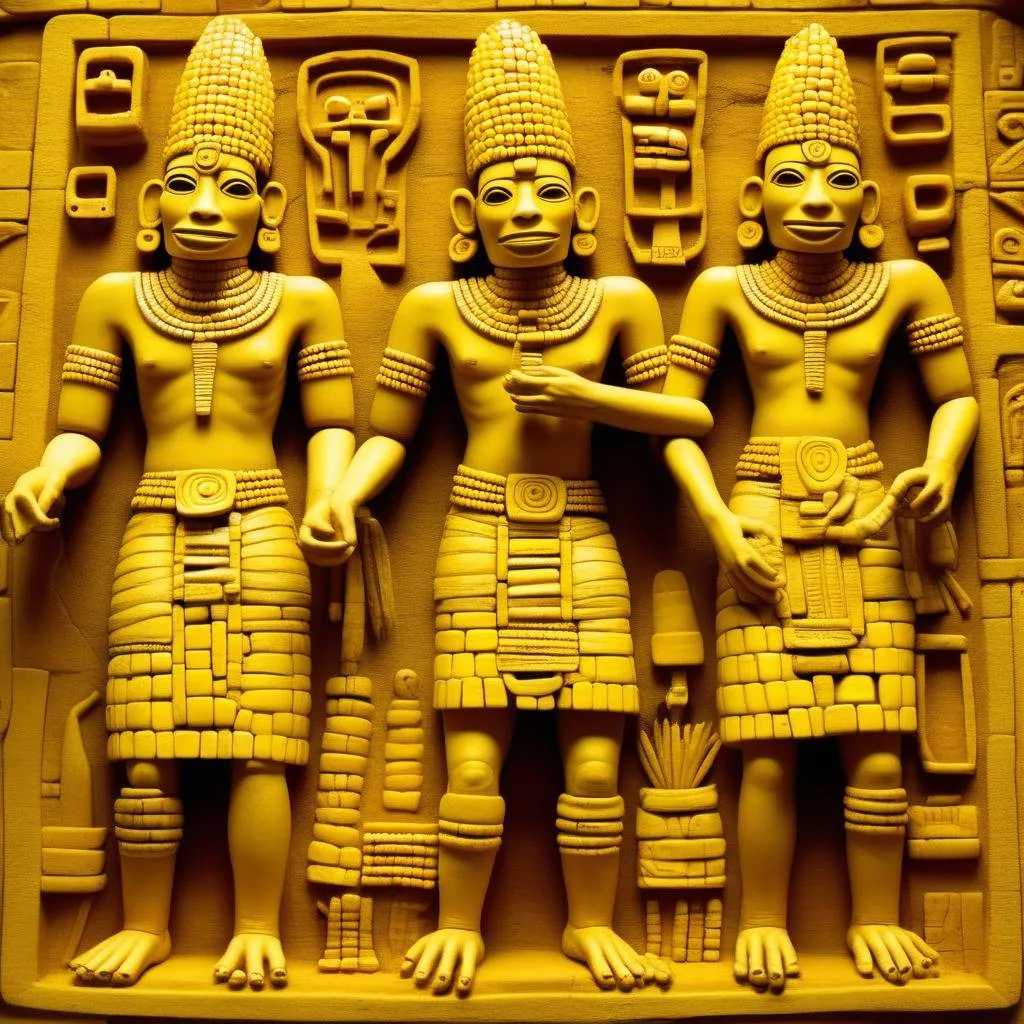
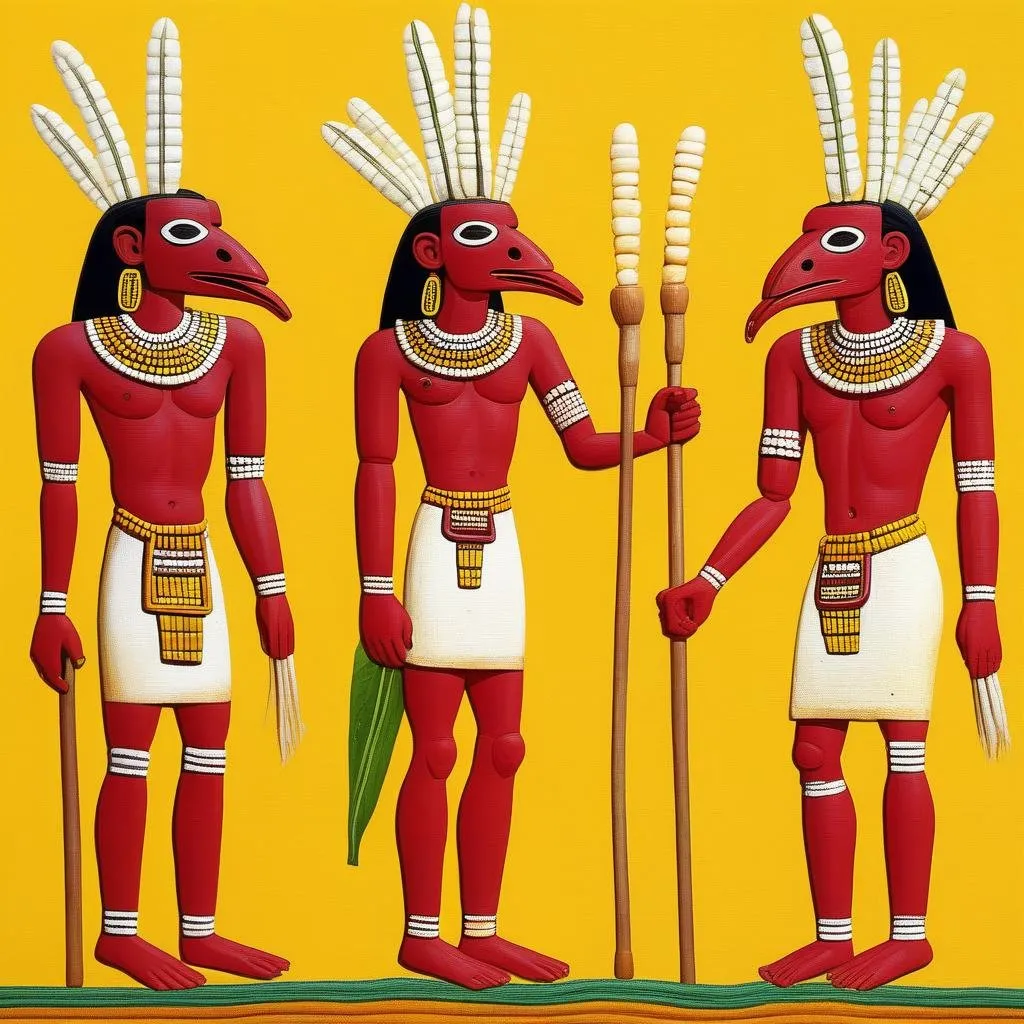
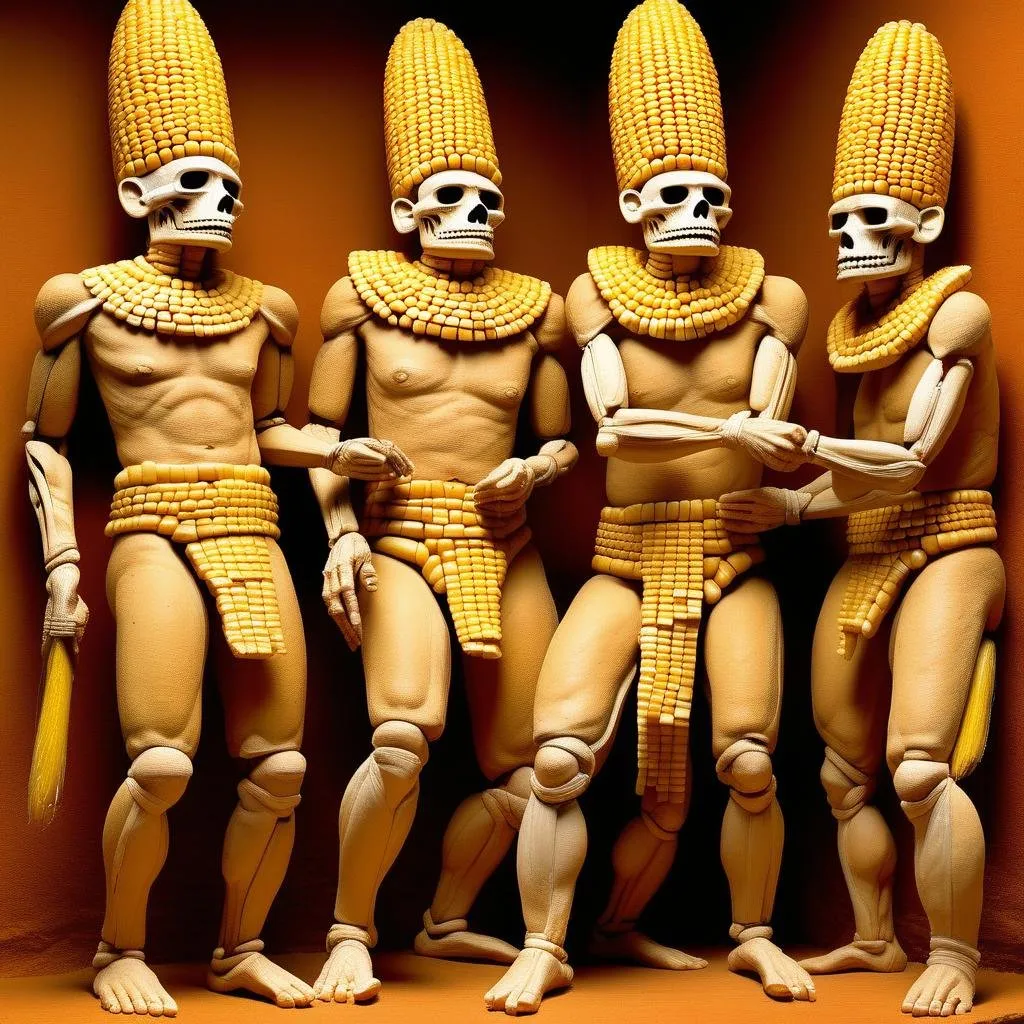
The Creation of the Mothers of the Quiche nation
Then their companions, their wives, also came to be. It was the gods alone who conceived them as well. As if it were in their sleep they received them. The women were truly beautiful who were with Balam Quitze, Balam Acab, Mahucutah, and Iqui Balam. Thus when the men were brought to life, their wives truly came to be as well. At once their hearts rejoiced because of their mates.
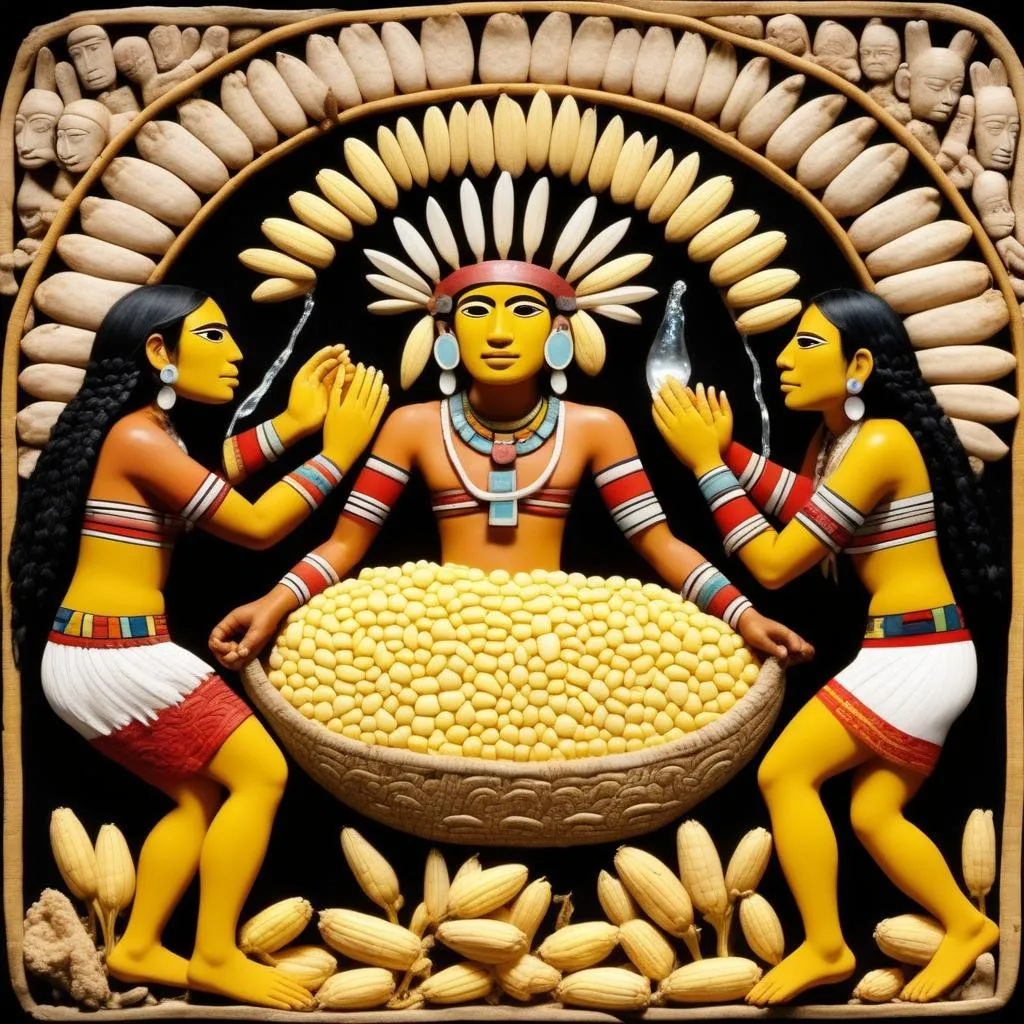
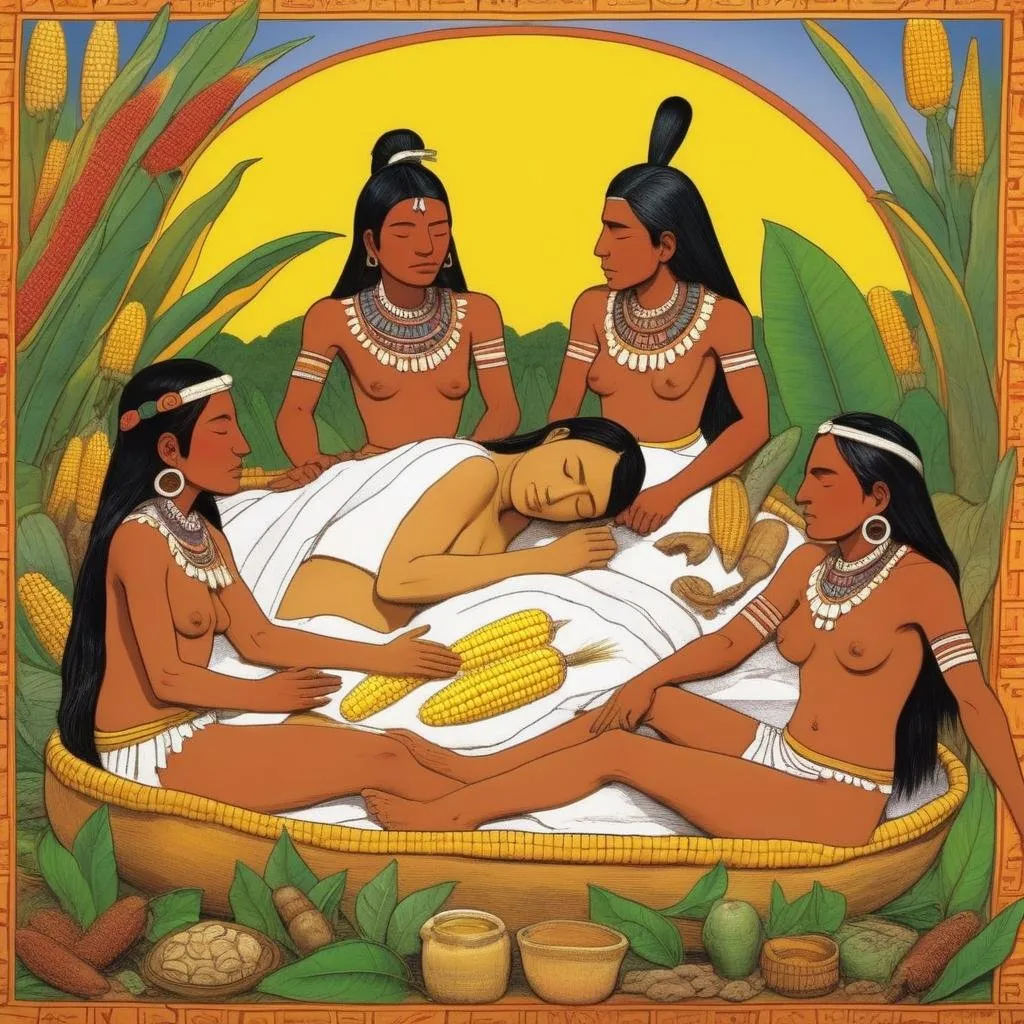
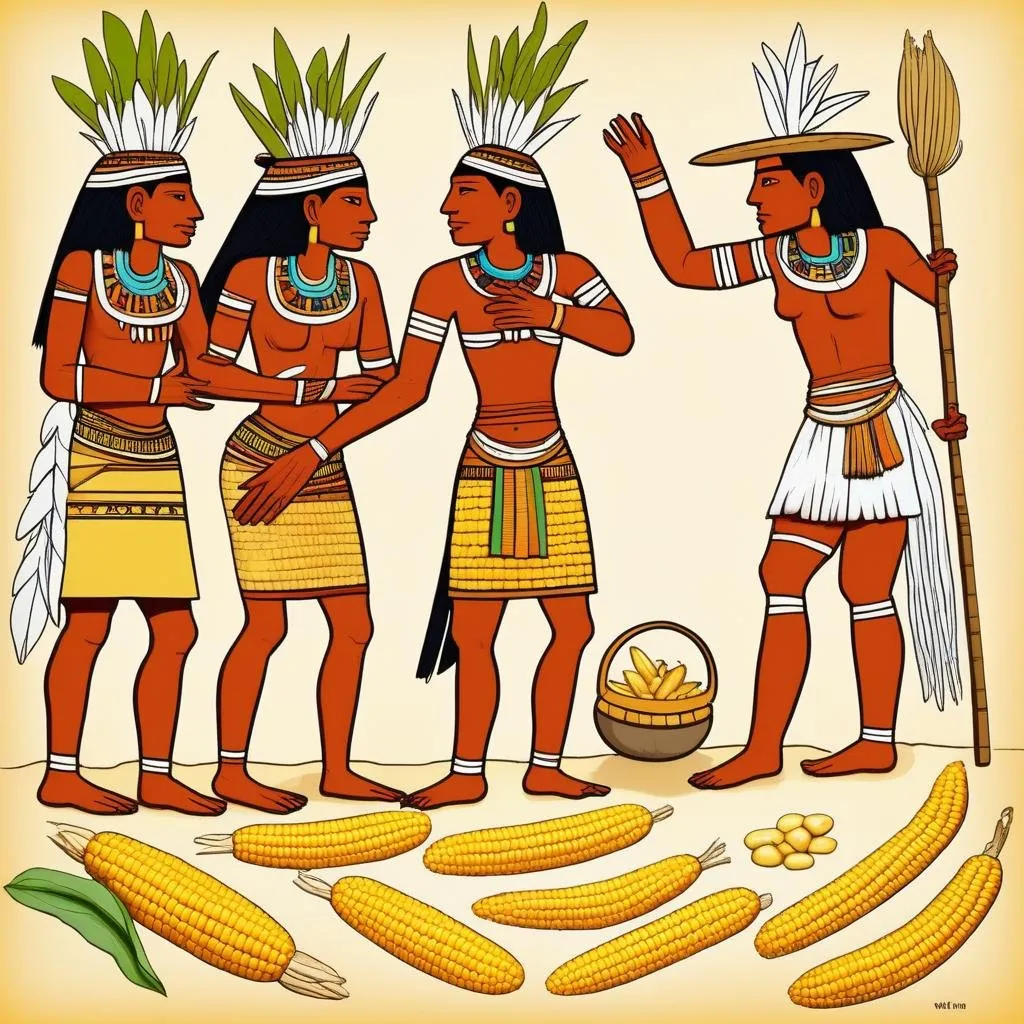
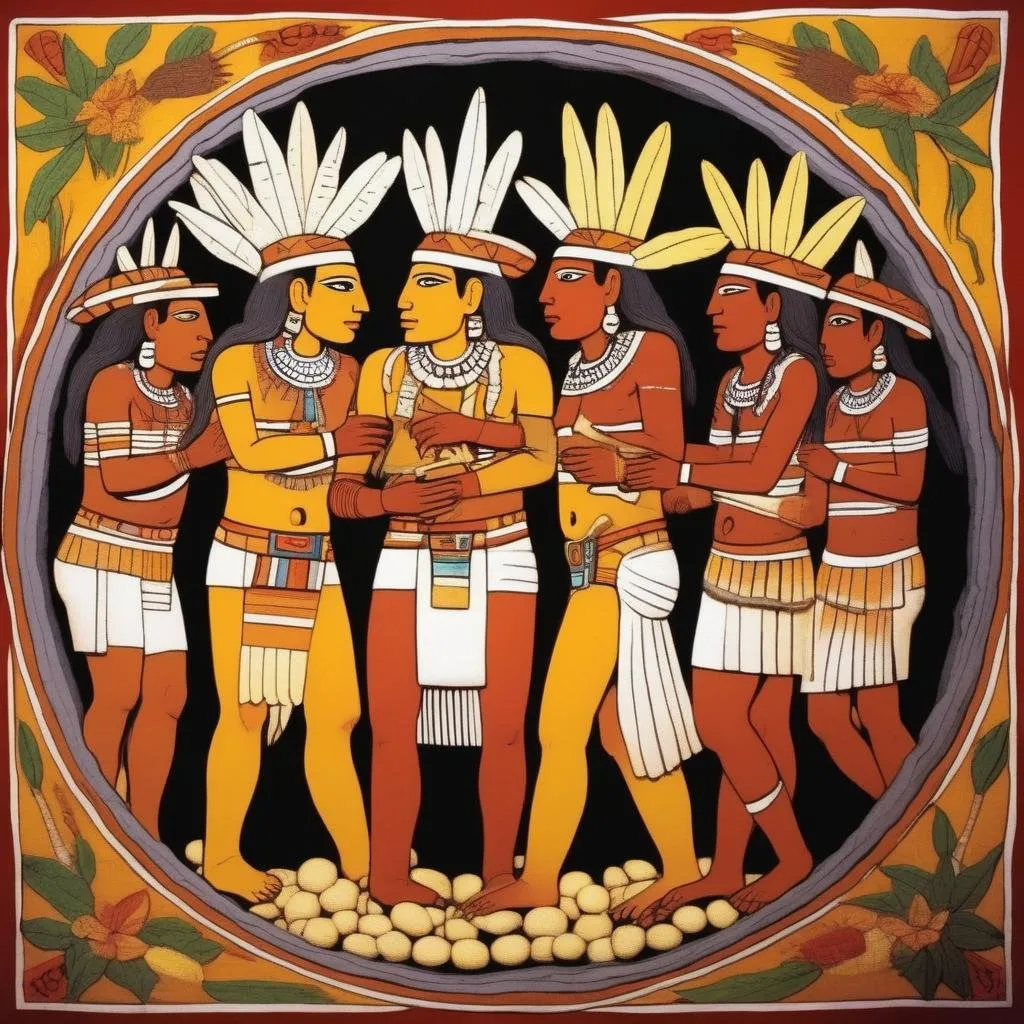
Conclusion
The Popol Vuh is a richly textured account of a people whose voice nearly faded from the historical record. This AI Art project is not meant to faithfully restore that vision because frankly, it is beyond the scope of any human alive today. But what about AI? Some of the stories found in the translated copy by Ximénez have been corroborated by the archeological record. So, it is not outside the realm of imagination for a scholar to input all that data into some AI software and recreate a more faithful account of images envisioned by the ancient K'iche'.
I hope you enjoyed it, and thank you for reading.
Resources
Christenson, Allen J. 2007. Popol Vuh: The Sacred Book of the Maya. Oklahoma ed. Norman: University of Oklahoma Press. http://catdir.loc.gov/catdir/toc/ecip0620/2006028164.html.
Images generated by @litguru using Generative Art software